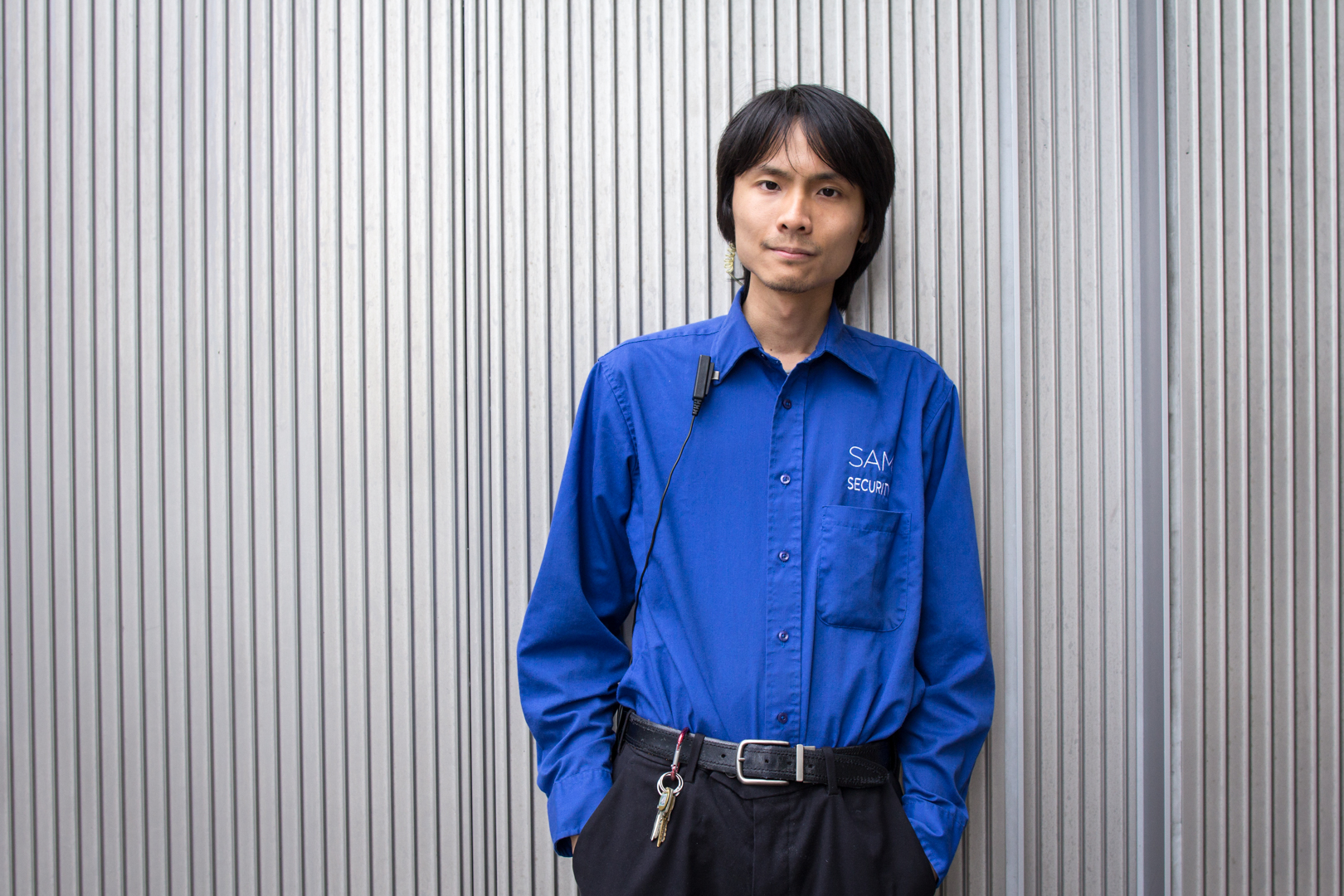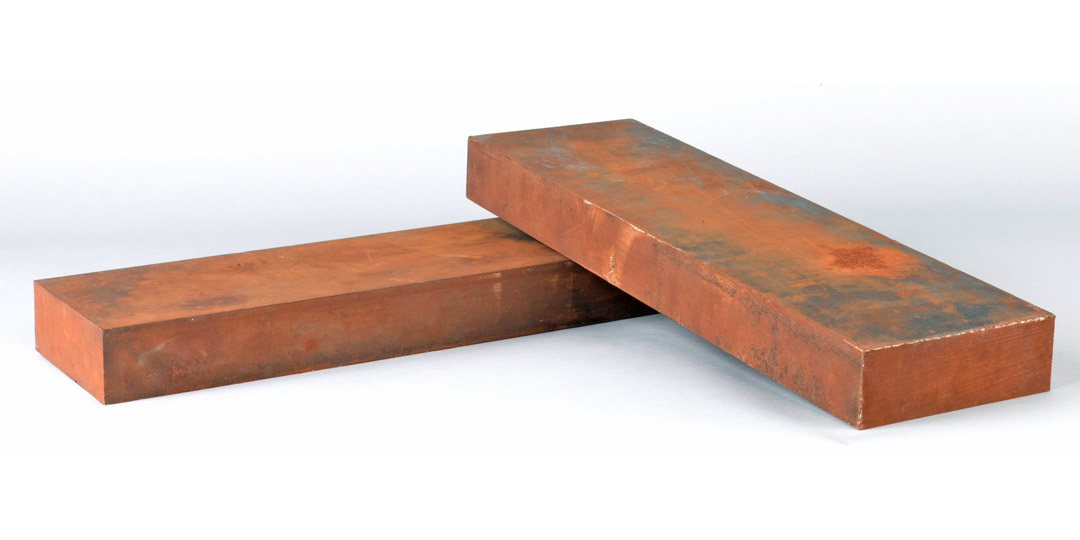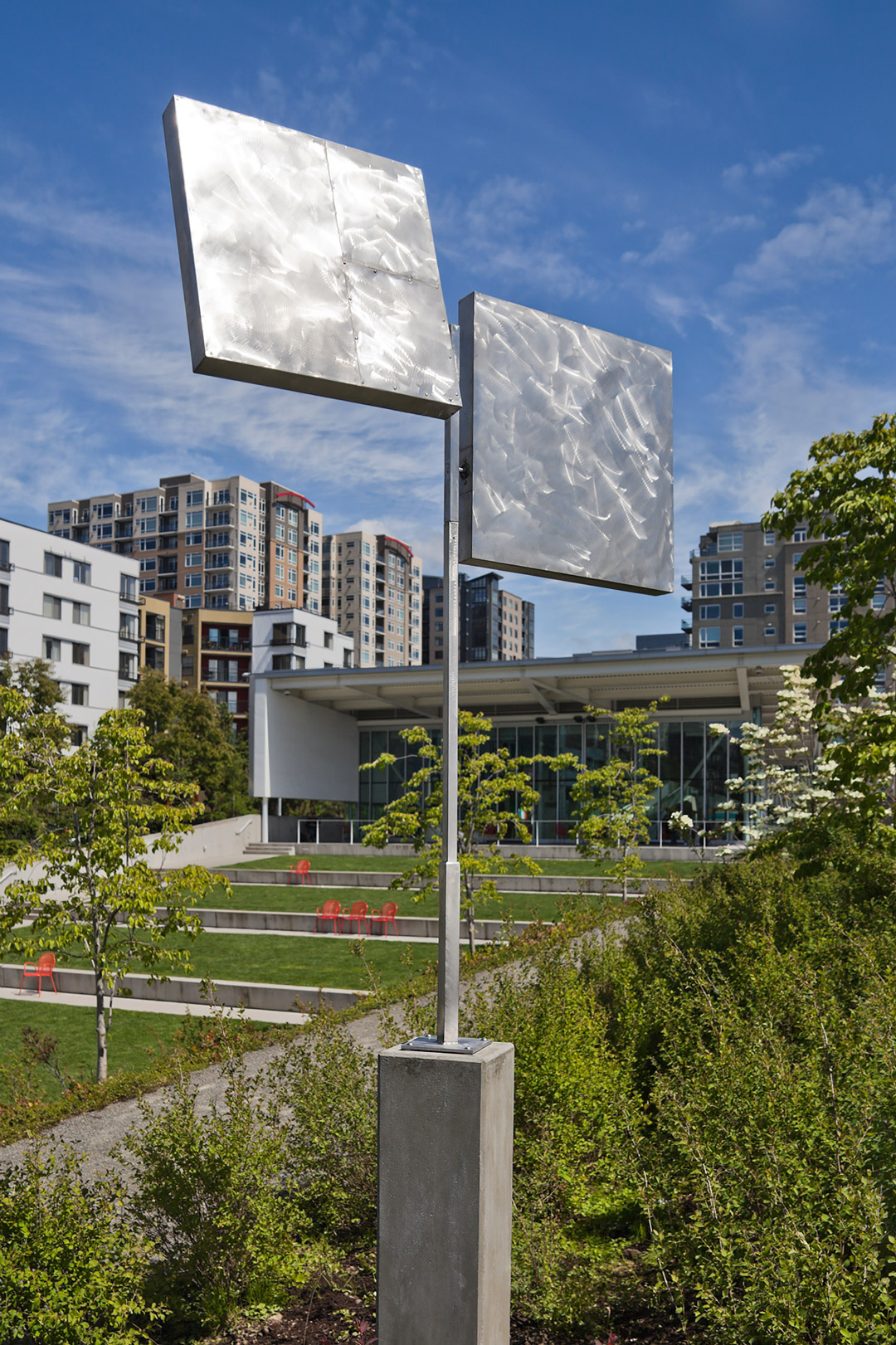Object of the Week: Untitled (2 Pieces)
For my first Object of the Week post as SAM’s new Collections Coordinator, I have chosen to highlight Untitled (2 Pieces) (1978) by American sculptor Richard Nonas. With a personal interest in modern and contemporary art, I have always found Nonas to be an under-recognized figure with an elusive body of work. But what is Object of the Week for, if not to engage deeper with art even if we feel challenged or uncomfortable in the process? We should never expect art to be straightforward—an important fact that challenges us to ask questions in order to better understand and appreciate an object’s history, meaning, and making—no matter how difficult or elusive it may be.
In Untitled (2 pieces) two steel brick-like forms, each measuring 6 x 2 x 22 inches, rest one on top of the other. Despite the weight of their physical makeup, there is a certain lightness to the stacked arrangement—a tenderness if you will. The patina on the steel surfaces further softens the cold, industrial material, adding a sense of age to these familiar yet enigmatic objects.
For decades, Nonas has created sculptural installations defined by their minimal aesthetic, intimate scale, geometric forms, and use of everyday materials such as wood, granite, and steel. Unlike his Minimalist contemporaries Donald Judd, Carl Andre, and Robert Morris, Nonas was distinctly interested in the emotional and spiritual qualities of artwork, rather than the removal of such expressions (a hallmark of Minimalism). For Nonas, the physical presence of his sculptures is just as important as the relationship—and emotional interaction—between object and viewer.
Prior to entering the art world in the 1970s, Nonas was an anthropologist. For ten years he conducted field work in northern Ontario, the Yukon Territory, Mexico, and Arizona.1 Speaking about his time in Mexico, the artist recalled “the extraordinary way those people conceived and perceived the world spatially, the ways they situated themselves contextually were unlike anything I knew in my own culture.”2 Nonas translated his observations and experiences as an anthropologist into an artistic practice aimed at challenging our notions of place and time.
His sculptural installations treat space as a medium, and transcend the cultural and historical associations we might bring to them. Just as the field of anthropology demands that we ask critical questions about cultures, objects, and the people who make them, Nonas’s sculptures, too, force us to search for meaning within the works and ourselves:
And making sculpture? I start with memories of how places feel. The ache of that desert, those woods, that room opening out. Places I’ve been, places I’ve seen and felt. And felt always with some component of unease, apprehension, disquiet, fear even, discomfort certainly. Memories of places that seem always slightly confusing, slightly ambiguous. Places whose meaning slips away, but not too far away.3
The world and spaces we occupy are constantly in flux, and Nonas seeks to embrace this contingent and ever-shifting aspect of our lived experience through his sculpture. Holding no singular interpretation or prescribed meaning, his pared down objects readily accept our all-too-human responses of uncertainty and doubt.
In addition to examining one of two Nonas sculptures in our collection, my hope is that Untitled (2 Pieces) might also act as an introduction and larger framework for future Object of the Week posts: By looking closely at SAM’s collection and asking questions what can we learn about an object, artist, people, or culture? And what can we learn by opening ourselves up to a particular work?
– Elisabeth Smith, Collections Coordinator
Image: Untitled (2 pieces), 1978, Richard Nonas, steel, 6 x 2 x 22 in. and 6 x 2 x 20in., The Dorothy and Herbert Vogel Collection: Fifty Works for Fifty States, a joint initiative of the Trustees of the Dorothy and Herbert Vogel Collection and the National Gallery of Art, with generous support from the National Endowment for the Arts and the Institute for Museum and Library Services, 2008.29.21
1 Susan Cross, Richard Nonas: The Man in the Empty Space (North Adams, MA: MASS MoCA, 2016), 4.
2 Alex Bacon, “In Conversation: Richard Nonas with Alex Bacon,” Brooklyn Rail, March 4, 2013, http://brooklynrail.org/2013/03/art/richard-nonas-with-alex-bacon.
3 Cross, Richard Nonas: The Man in the Empty Space, 4.
Object of the Week: Two Plane Vertical Horizontal Variation III
It’s early October and the sun is still shining in Seattle. These early fall days in the Northwest always feel like something special: a lull between the over-scheduled blaze of the summer and the damp grayness of winter, when Seattleites can still take advantage of the great outdoors. And what better way to do so than with a stroll through the Olympic Sculpture Park, visiting some old favorites—or maybe some sculptures you may have missed among the summer crowds.
Tucked away at the top of the park’s signature Z-path is George Rickey’s Two Plane Vertical Horizontal Variation III (1973). A deceptively simple composition, the sculpture consists of two stainless steel square elements, mounted slightly offset from each other on a tall pole. The surfaces of the squares are burnished in a gestural, almost painterly pattern, perhaps belying Rickey’s early background as a painter. Overall, its simplified geometric forms, lines, and planes are reminiscent of a history of constructivism—an early 20th century avant-garde movement on which Rickey published a book in 1967—and the aesthetics of the New York minimalist artists who were his contemporaries. What really distinguishes Rickey’s work, though, is not its form or material, but a different element altogether: movement.
Rickey was one of the pioneers who brought movement to abstract sculpture. Referring to them as “useless machines,” his kinetic works are meticulously engineered so that their components shift, rotate, or spin with even the slightest breeze. In the case of Two Plane Vertical Horizontal Variation III, the seemingly simple squares are in fact compound pendulums, spinning around a central point (the heart of the plane) in parallel paths. They respond directly to the effects of nature, from the most dramatic windstorm to the lightest gust of air.
It is fitting that Two Plane Vertical Horizontal Variation III is located so near Alexander Calder’s iconic Eagle, as Calder’s kinetic sculptures were a major influence on Rickey’s own “useless machines.” But where Calder’s work exudes a playful, organic, biomorphic quality, Rickey’s is rooted in geometric exactitude, an interest in the poetry of a precisely engineered object. He recalls the development of these ideas when he began making kinetic works in 1949:
I committed myself to a completely new technology, a new esthetic, new criteria, a new kind of response from others and a new antiphony between myself and the new object I held in my hand. I had to wonder whether Calder had said it all; when I found he had not, I had to choose among the many doors I then found open. I had to learn to be a mechanic and to recall the physics I had learned at 16. . . . I had embarked on a long-term project—to make an art in which every object had to be preconceived and had to be able to go through its motions completely and satisfactorily, or I had made nothing at all.1
The sculpture is only truly activated when this order with which it was designed—based in an acute understanding of mathematics, engineering, and physics—comes into contact with the disorder of nature. Rickey intended this interaction—he meant for his kinetic sculptures to be installed outdoors, bearing all of the elements—and it is in this interplay between science and nature where the work is its most lyrical. So the next time you’re taking advantage of a sunny fall day in the sculpture park, I invite you to stay awhile and watch the sculpture at work—spinning precisely and gracefully as it heralds every change in the weather.
– Carrie Dedon, Assistant Curator of Modern and Contemporary Art


